I–D Threshold Analysis of Rainfall-Triggered Landslides Based on TRMM Precipitation Data in Wudu, China
Abstract
:1. Introduction
2. Wudu County
3. Data and Methods
3.1. Data
3.2. Methods
3.2.1. Downscaling Model Construction
3.2.2. ANUSPLIN Interpolation
3.2.3. Calculation of landslide Rainfall Threshold
3.2.4. Validation of Interpolation and Downscaling Model
3.2.5. Validation of Landslide Rainfall Threshold
4. Results
4.1. Interpolation and Downscaling Validation
4.2. Analysis and Validation of Landslide Rainfall Threshold
4.3. Different Influencing Factors and Landslide Rainfall Thresholds
4.3.1. Different Intense Rainfall Events and Thresholds
4.3.2. Landforms and Thresholds
4.3.3. Topographic Slopes and Thresholds
4.3.4. Soils and Thresholds
5. Discussion
6. Conclusions
Author Contributions
Funding
Data Availability Statement
Acknowledgments
Conflicts of Interest
References
- Guzzetti, F.; Peruccacci, S.; Rossi, M.; Stark, C.P. Rainfall thresholds for the initiation of landslides in central and southern Europe. Meteorol. Atmos. Phys. 2007, 98, 239–267. [Google Scholar] [CrossRef]
- Rossi, M.; Kirschbaum, D.; Valigi, D.; Mondini, A.; Guzzetti, F. Comparison of Satellite Rainfall Estimates and Rain Gauge Measurements in Italy, and Impact on Landslide Modeling. Climate 2017, 5, 90. [Google Scholar] [CrossRef] [Green Version]
- Hong, Y.; Adler, R.; Huffman, G. Evaluation of the potential of NASA multi-satellite precipitation analysis in global landslide hazard assessment. Geophys Res. Lett. 2006, 33, L22402. [Google Scholar] [CrossRef]
- Hong, Y.; Adler, R.F.; Huffman, G. An Experimental Global Prediction System for Rainfall-Triggered Landslides Using Satellite Remote Sensing and Geospatial Datasets. IEEE Trans. Geosci. Remote Sens. 2007, 45, 1671–1680. [Google Scholar] [CrossRef]
- Kirschbaum, D.B.; Adler, R.; Hong, Y.; Lerner-Lam, A. Evaluation of a preliminary satellite-based landslide hazard algorithm using global landslide inventories. Nat. Hazards Earth Syst. Sci. 2009, 9, 673–686. [Google Scholar] [CrossRef] [Green Version]
- Kirschbaum, D.B.; Adler, R.; Hong, Y.; Kumar, S.; Peters-Lidard, C.; Lerner-Lam, A. Advances in landslide nowcasting: Evaluation of a global and regional modeling approach. Environ. Earth Sci. 2011, 66, 1683–1696. [Google Scholar] [CrossRef] [Green Version]
- Turkington, T.; Ettema, J.; van Westen, C.J.; Breinl, K. Empirical atmospheric thresholds for debris flows and flash floods in the southern French Alps. Nat. Hazards Earth Syst. Sci. 2014, 14, 1517–1530. [Google Scholar] [CrossRef] [Green Version]
- Robbins, J.C. A probabilistic approach for assessing landslide-triggering event rainfall in Papua New Guinea, using TRMM satellite precipitation estimates. J. Hydrol. 2016, 541, 296–309. [Google Scholar] [CrossRef]
- Chikalamo, E.E.; Mavrouli, O.C.; Ettema, J.; van Westen, C.J.; Muntohar, A.S.; Mustofa, A. Satellite-derived rainfall thresholds for landslide early warning in Bogowonto Catchment, Central Java, Indonesia. Int. J. Appl. Earth Obs. Geoinf. 2020, 89, 102093. [Google Scholar] [CrossRef]
- Bordoni, M.; Vivaldi, V.; Lucchelli, L.; Ciabatta, L.; Brocca, L.; Galve, J.P.; Meisina, C. Development of a data-driven model for spatial and temporal shallow landslide probability of occurrence at catchment scale. Landslides 2021, 18, 1209–1229. [Google Scholar] [CrossRef]
- Uwihirwe, J.; Riveros, A.; Wanjala, H.; Schellekens, J.; Sperna Weiland, F.; Hrachowitz, M.; Bogaard, T.A. Potential of satellite-derived hydro-meteorological information for landslide initiation thresholds in Rwanda. Nat. Hazards Earth Syst. Sci. 2022, 22, 3641–3661. [Google Scholar] [CrossRef]
- Jiang, W.; Chen, G.; Meng, X.; Jin, J.; Zhao, Y.; Lin, L.; Li, Y.; Zhang, Y. Probabilistic rainfall threshold of landslides in Data-Scarce mountainous Areas: A case study of the Bailong River Basin, China. Catena 2022, 213, 106190. [Google Scholar] [CrossRef]
- Li, J.; Liu, Z.; Wang, R.; Zhang, X.; Liu, X.; Yao, Z. Analysis of Debris Flow Triggering Conditions for Different Rainfall Patterns Based on Satellite Rainfall Products in Hengduan Mountain Region, China. Remote Sens. 2022, 14, 2731. [Google Scholar] [CrossRef]
- Tiranti, D.; Rabuffetti, D. Estimation of rainfall thresholds triggering shallow landslides for an operational warning system implementation. Landslides 2010, 7, 471–481. [Google Scholar] [CrossRef]
- Malamud, B.D.; Turcotte, D.L.; Guzzetti, F.; Reichenbach, P. Landslide inventories and their statistical properties. Earth Surf. Process. Landf. 2004, 29, 687–711. [Google Scholar] [CrossRef]
- Chen, C.-Y. Landslide and basin self-organized criticality in the Lushan Hot Spring area. J. Mt. Sci. 2012, 9, 463–471. [Google Scholar] [CrossRef]
- Toté, C.; Patricio, D.; Boogaard, H.; van der Wijngaart, R.; Tarnavsky, E.; Funk, C. Evaluation of Satellite Rainfall Estimates for Drought and Flood Monitoring in Mozambique. Remote Sens. 2015, 7, 1758–1776. [Google Scholar] [CrossRef] [Green Version]
- Ullah, W.; Wang, G.; Ali, G.; Tawia Hagan, D.; Bhatti, A.; Lou, D. Comparing Multiple Precipitation Products against In-Situ Observations over Different Climate Regions of Pakistan. Remote Sens. 2019, 11, 628. [Google Scholar] [CrossRef] [Green Version]
- Tang, G.; Clark, M.P.; Papalexiou, S.M.; Ma, Z.; Hong, Y. Have satellite precipitation products improved over last two decades? A comprehensive comparison of GPM IMERG with nine satellite and reanalysis datasets. Remote Sens. Environ. 2020, 240, 111697. [Google Scholar] [CrossRef]
- Mei, Y.; Maggioni, V.; Houser, P.; Xue, Y.; Rouf, T. A Nonparametric Statistical Technique for Spatial Downscaling of Precipitation Over High Mountain Asia. Water Resour. Res. 2020, 56, e2020WR027472. [Google Scholar] [CrossRef]
- Jiang, Y.; Yang, K.; Qi, Y.; Zhou, X.; He, J.; Lu, H.; Li, X.; Chen, Y.; Li, X.; Zhou, B.; et al. TPHiPr: A long-term (1979–2020) high-accuracy precipitation dataset (1∕30°, daily) for the Third Pole region based on high-resolution atmospheric modeling and dense observations. Earth Syst. Sci. Data 2023, 15, 621–638. [Google Scholar] [CrossRef]
- Ning, S.; Zhou, H.-W.; Zhang, Z.-Y.; Bai, S.-B.; Liu, L. Precipitation scale effect of the TRMM satellite in Tianshan, China. J. Mt. Sci. 2023, 20, 1349–1368. [Google Scholar] [CrossRef]
- Kumar Thakur, M.; Desamsetti, S.; Naga Rajesh, A.; Koteswara Rao, K.; Narayanan, M.S.; Lakshmi Kumar, T.V. Exploring the rainfall data from satellites to monitor rainfall induced landslides—A case study. Adv. Space Res. 2020, 66, 887–894. [Google Scholar] [CrossRef]
- Bai, S.; Wang, J.; Thiebes, B.; Cheng, C.; Yang, Y. Analysis of the relationship of landslide occurrence with rainfall: A case study of Wudu County, China. Arab. J. Geosci. 2014, 7, 1277–1285. [Google Scholar] [CrossRef]
- Bai, S.-B.; Cheng, C.; Wang, J.; Thiebes, B.; Zhang, Z.-G. Regional scale rainfall- and earthquake-triggered landslide susceptibility assessment in Wudu County, China. J. Mt. Sci. 2013, 10, 743–753. [Google Scholar] [CrossRef]
- Guo, B.; Zhang, J.; Meng, X.; Xu, T.; Song, Y. Long-term spatio-temporal precipitation variations in China with precipitation surface interpolated by ANUSPLIN. Sci. Rep. 2020, 10, 81. [Google Scholar] [CrossRef] [Green Version]
- Rainer, B.; Thomas, G.; Xi, Y.; Bai, S.; Benni, T. Combining landslide susceptibility maps and rainfall thresholds using a matrix approach. Rev. Geomorfol. 2017, 19, 58–74. [Google Scholar] [CrossRef]
- Zhang, S.; Sun, P.; Li, R.; Zhang, Y.; Ren, J. Distribution feature and development characteristics of geohazards in Wudu district, Gansu province, Northwest China. Geoenviron. Disasters 2022, 9, 23. [Google Scholar] [CrossRef]
- Zhang, Q.; Singh, V.P.; Li, J.; Jiang, F.; Bai, Y. Spatio-temporal variations of precipitation extremes in Xinjiang, China. J. Hydrol. 2012, 434–435, 7–18. [Google Scholar] [CrossRef]
- Breiman, L. Random forests. Mach. Learn. 2001, 45, 5–32. [Google Scholar] [CrossRef] [Green Version]
- He, X.; Chaney, N.W.; Schleiss, M.; Sheffield, J. Spatial downscaling of precipitation using adaptable random forests. Water Resour. Res. 2016, 52, 8217–8237. [Google Scholar] [CrossRef]
- Tan, J.; Xie, X.; Zuo, J.; Xing, X.; Liu, B.; Xia, Q.; Zhang, Y. Coupling random forest and inverse distance weighting to generate climate surfaces of precipitation and temperature with Multiple-Covariates. J. Hydrol. 2021, 598, 126270. [Google Scholar] [CrossRef]
- Zhang, X.; Shao, J.; Luo, H. Spatial interpolation of air temperature with ANUSPLIN in Three Gorges Reservoir Area. In Proceedings of the 2011 International Conference on Remote Sensing, Environment and Transportation Engineering, Nanjing, China, 24–26 June 2011; pp. 3465–3468. [Google Scholar]
- Tang, C.; van Asch, T.W.J.; Chang, M.; Chen, G.Q.; Zhao, X.H.; Huang, X.C. Catastrophic debris flows on 13 August 2010 in the Qingping area, southwestern China: The combined effects of a strong earthquake and subsequent rainstorms. Geomorphology 2012, 139–140, 559–576. [Google Scholar] [CrossRef]
- Mandal, P.; Sarkar, S. Estimation of rainfall threshold for the early warning of shallow landslides along National Highway-10 in Darjeeling Himalayas. Nat. Hazards 2021, 105, 2455–2480. [Google Scholar] [CrossRef]
- Crozier, M.J. Prediction of rainfall-triggered landslides: A test of the Antecedent Water Status Model. Earth Surf. Process. Landf. 1999, 24, 825–833. [Google Scholar] [CrossRef]
- Mirus, B.B.; Becker, R.E.; Baum, R.L.; Smith, J.B. Integrating real-time subsurface hydrologic monitoring with empirical rainfall thresholds to improve landslide early warning. Landslides 2018, 15, 1909–1919. [Google Scholar] [CrossRef]
- Zhao, B.; Dai, Q.; Han, D.; Dai, H.; Mao, J.; Zhuo, L.; Rong, G. Estimation of soil moisture using modified antecedent precipitation index with application in landslide predictions. Landslides 2019, 16, 2381–2393. [Google Scholar] [CrossRef]
- Ma, T.; Li, C.; Lu, Z.; Bao, Q. Rainfall intensity–duration thresholds for the initiation of landslides in Zhejiang Province, China. Geomorphology 2015, 245, 193–206. [Google Scholar] [CrossRef]


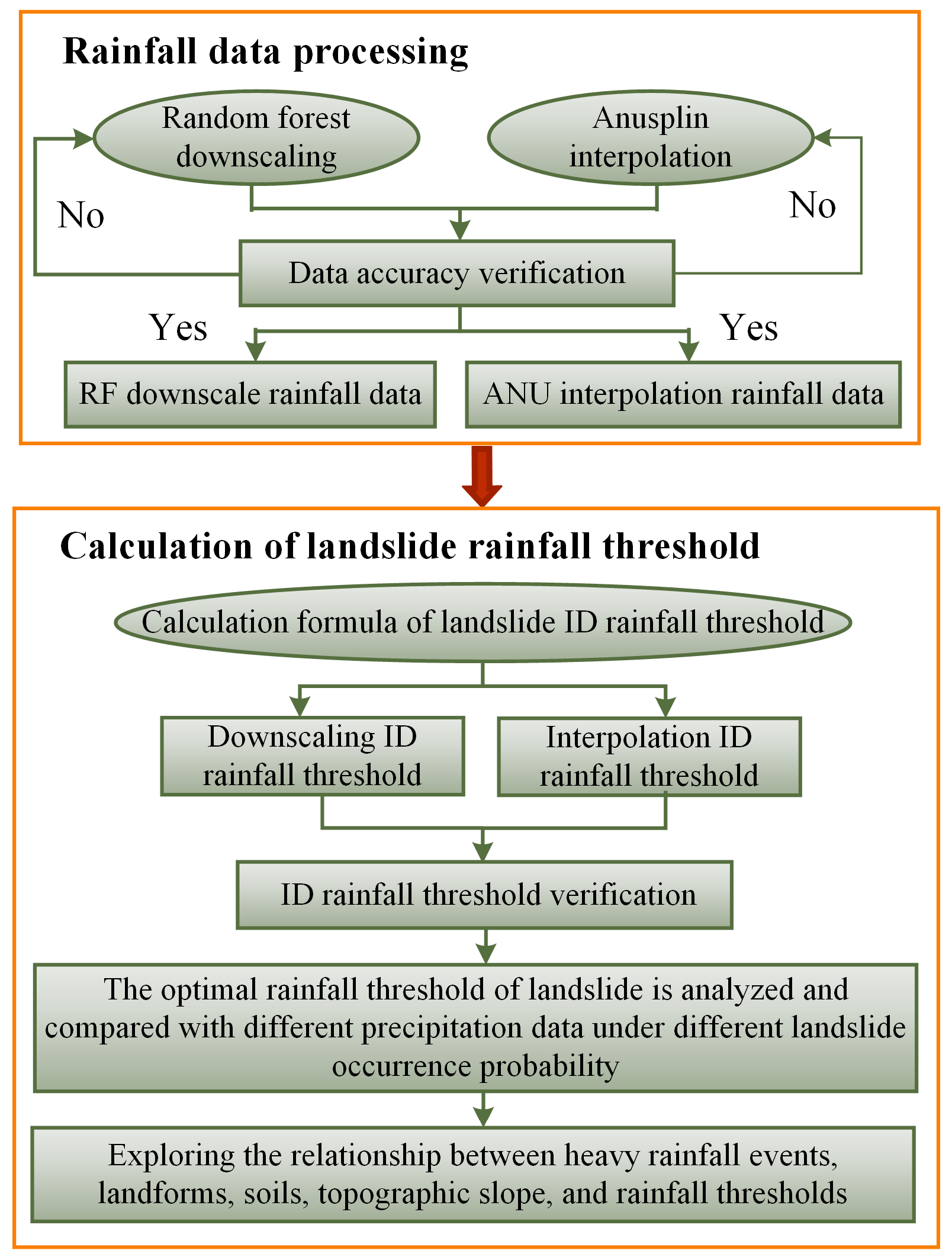
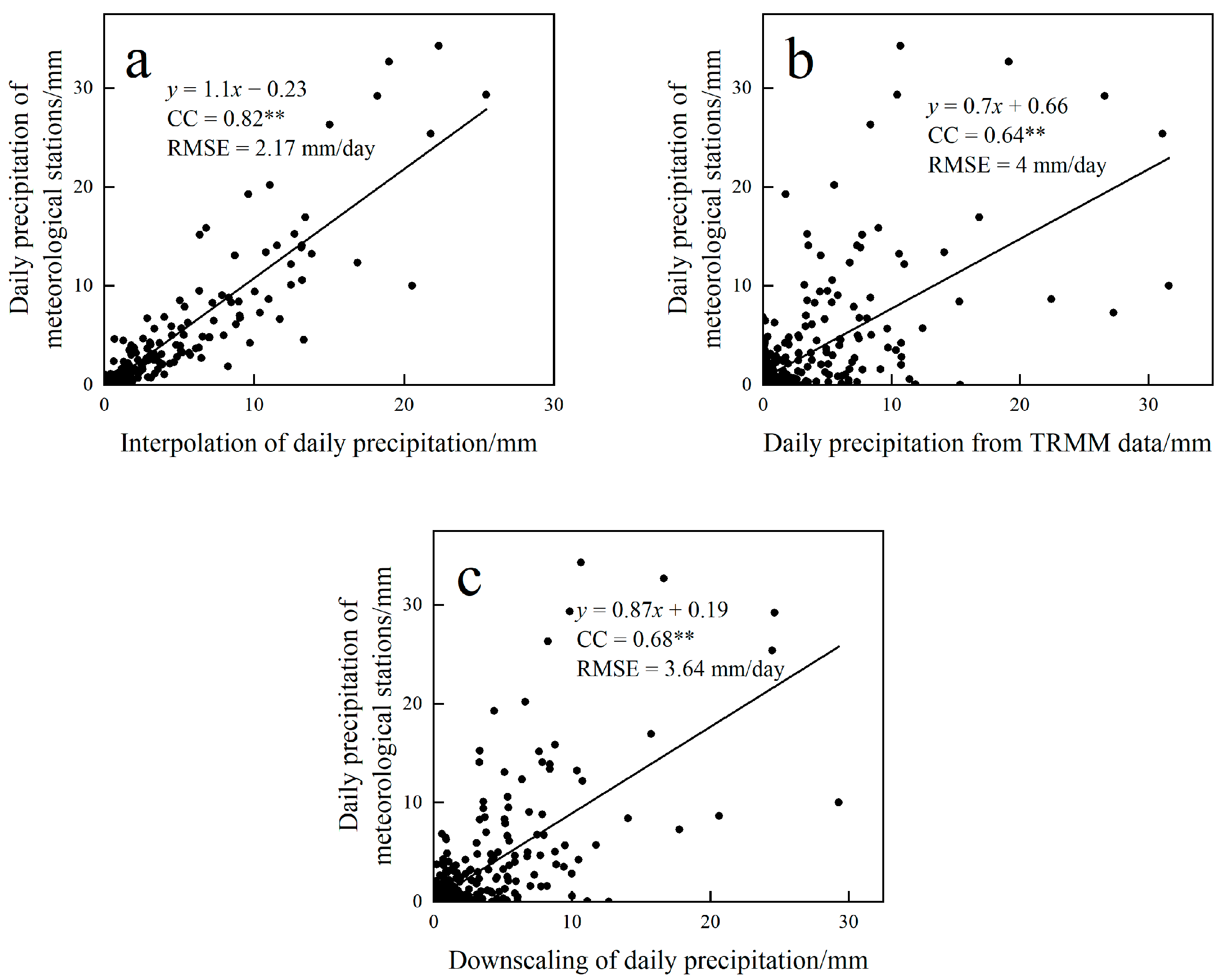
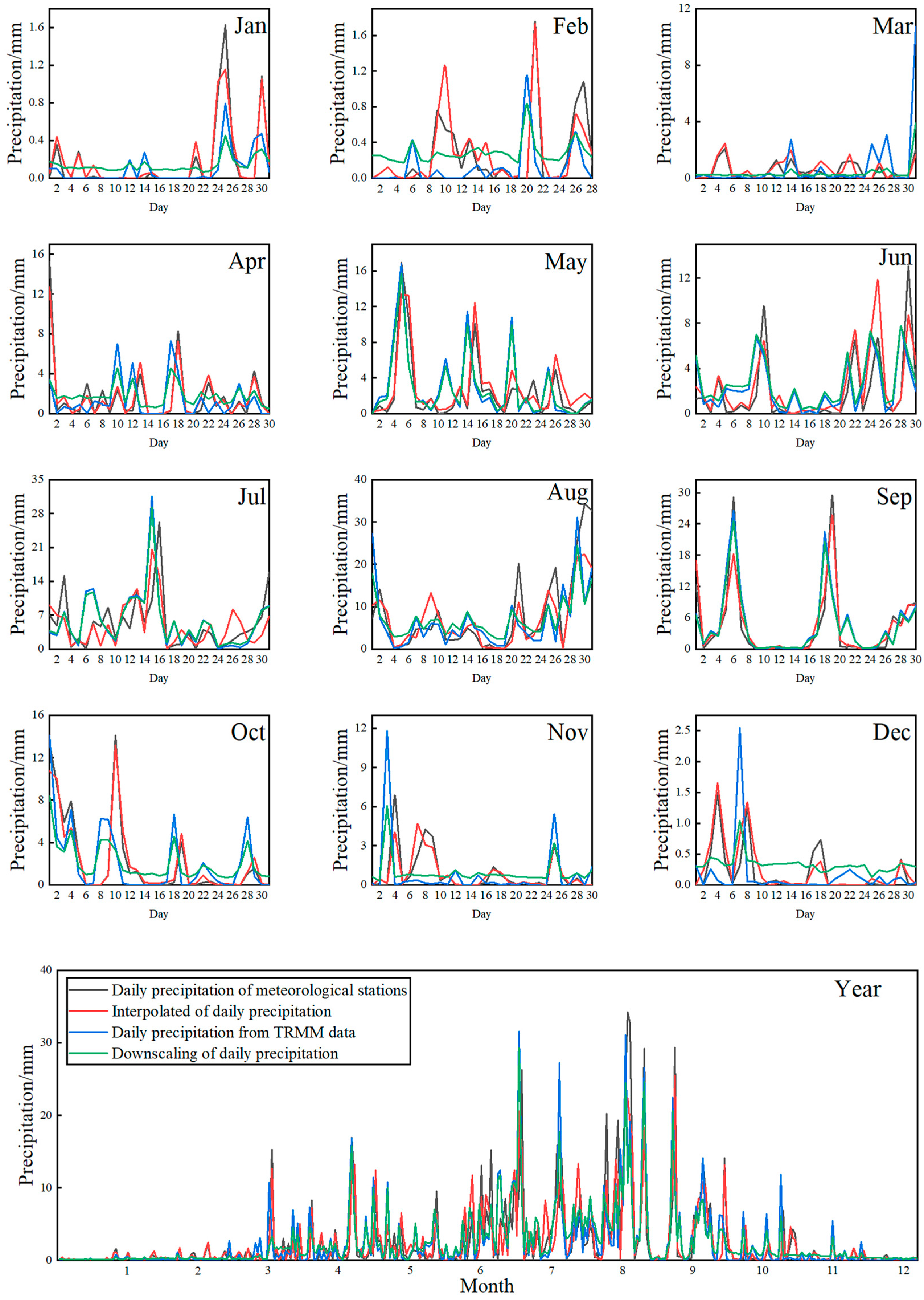


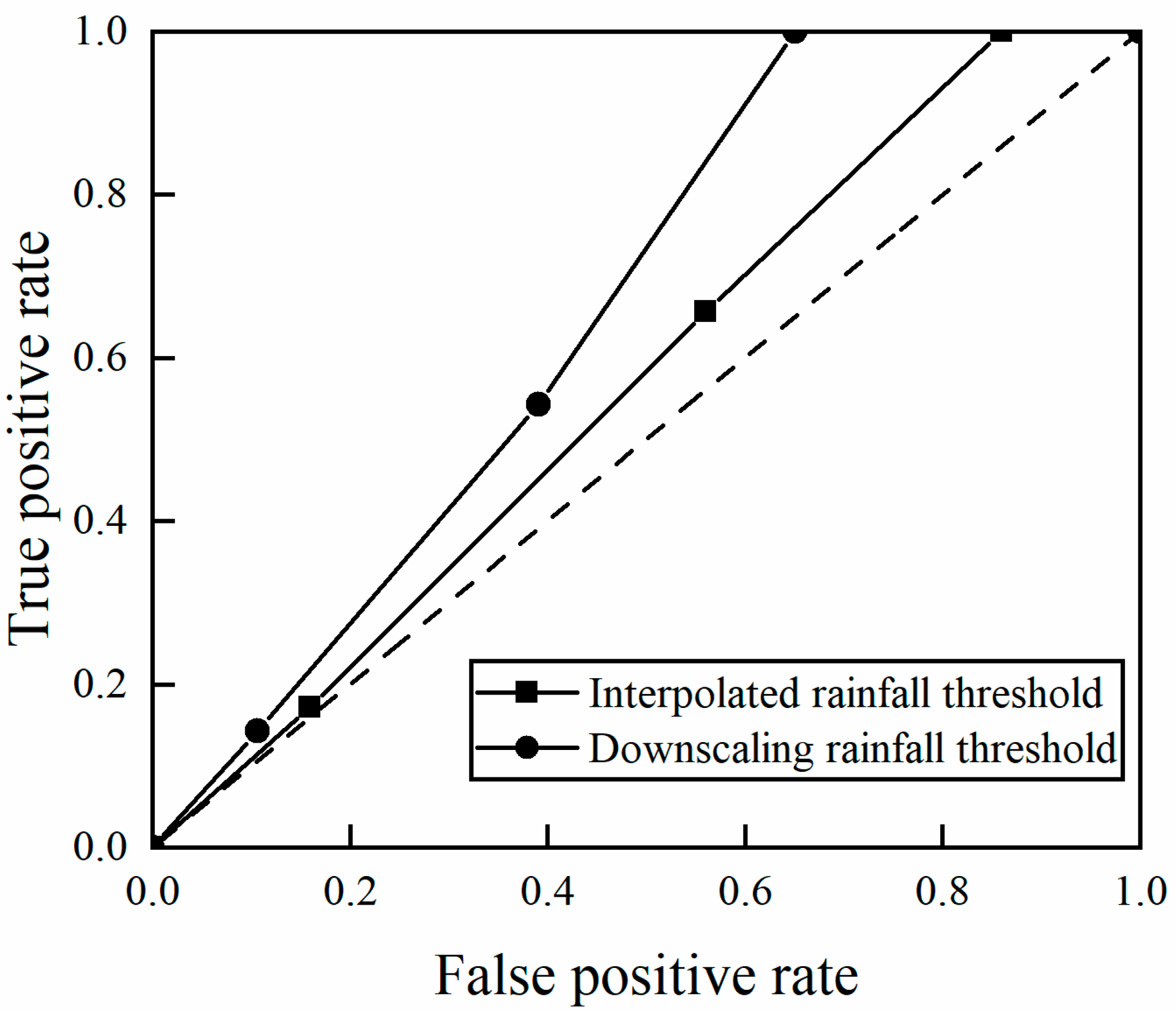
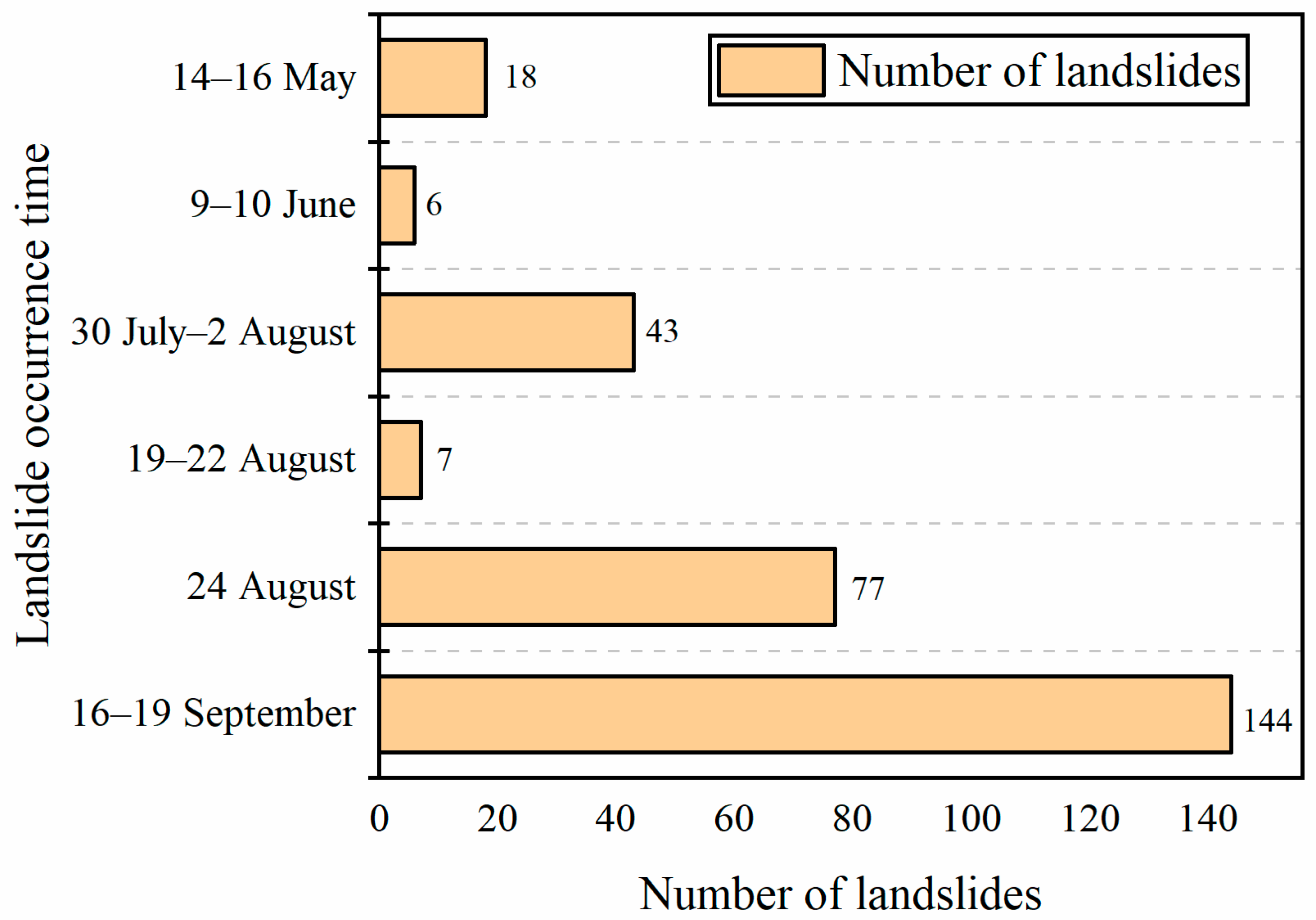
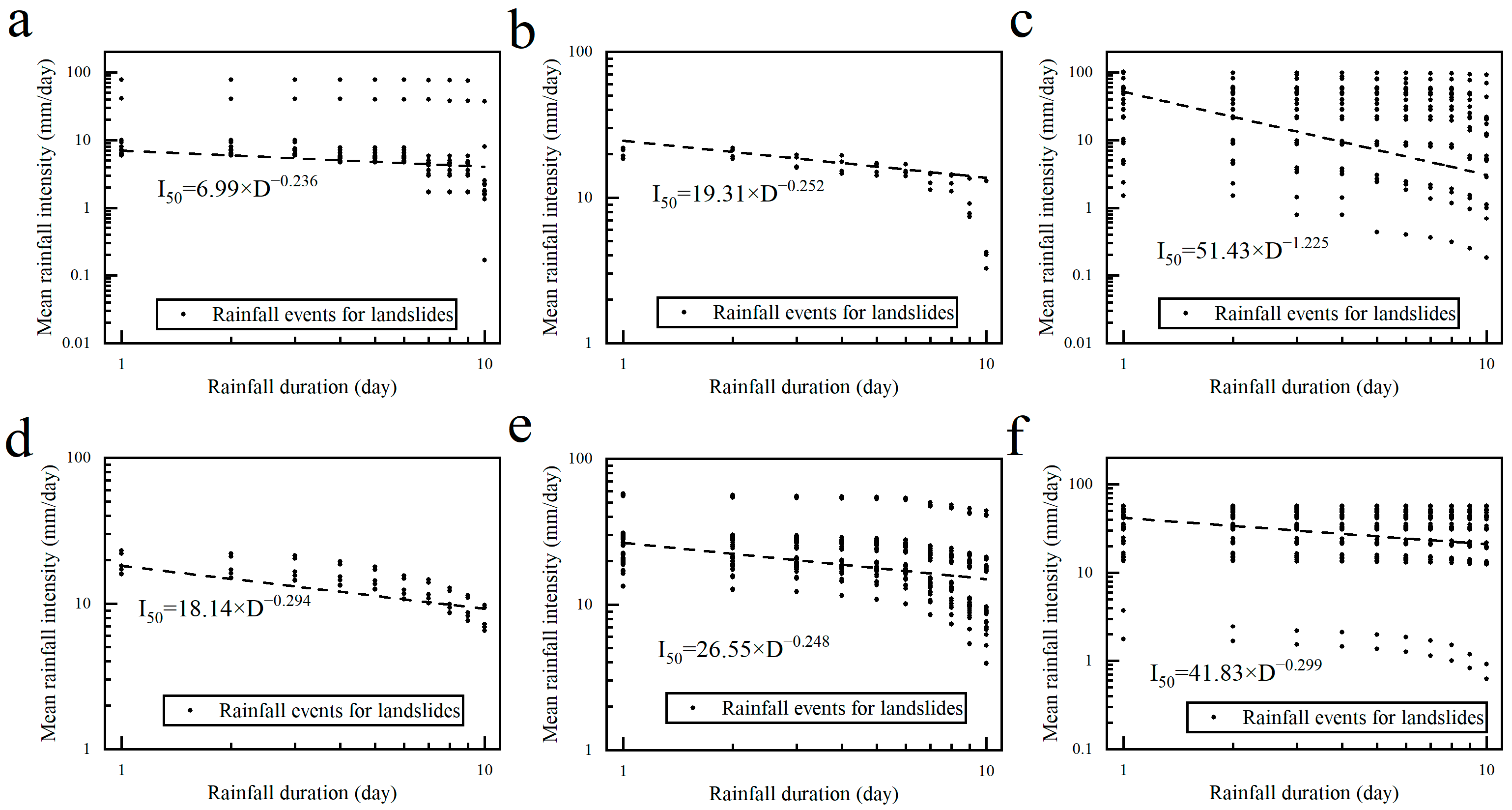
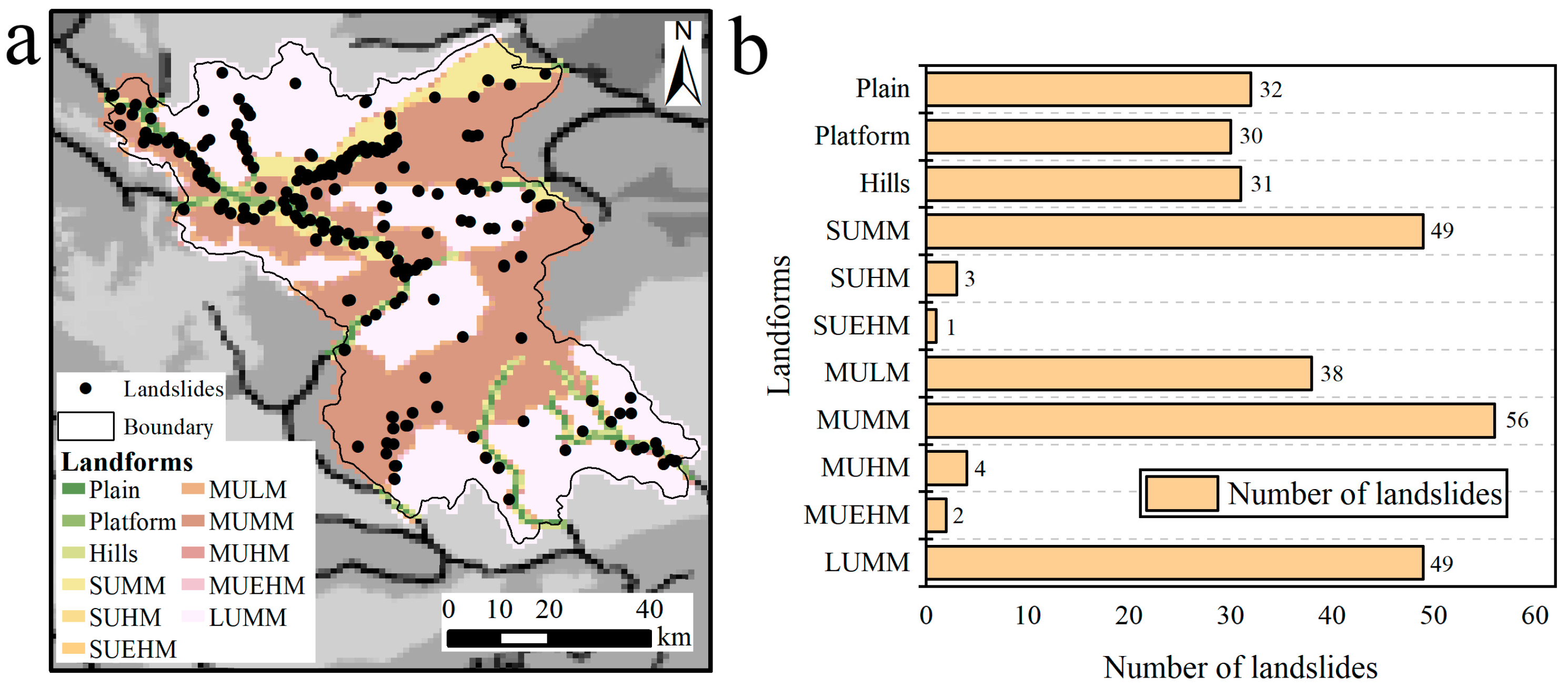
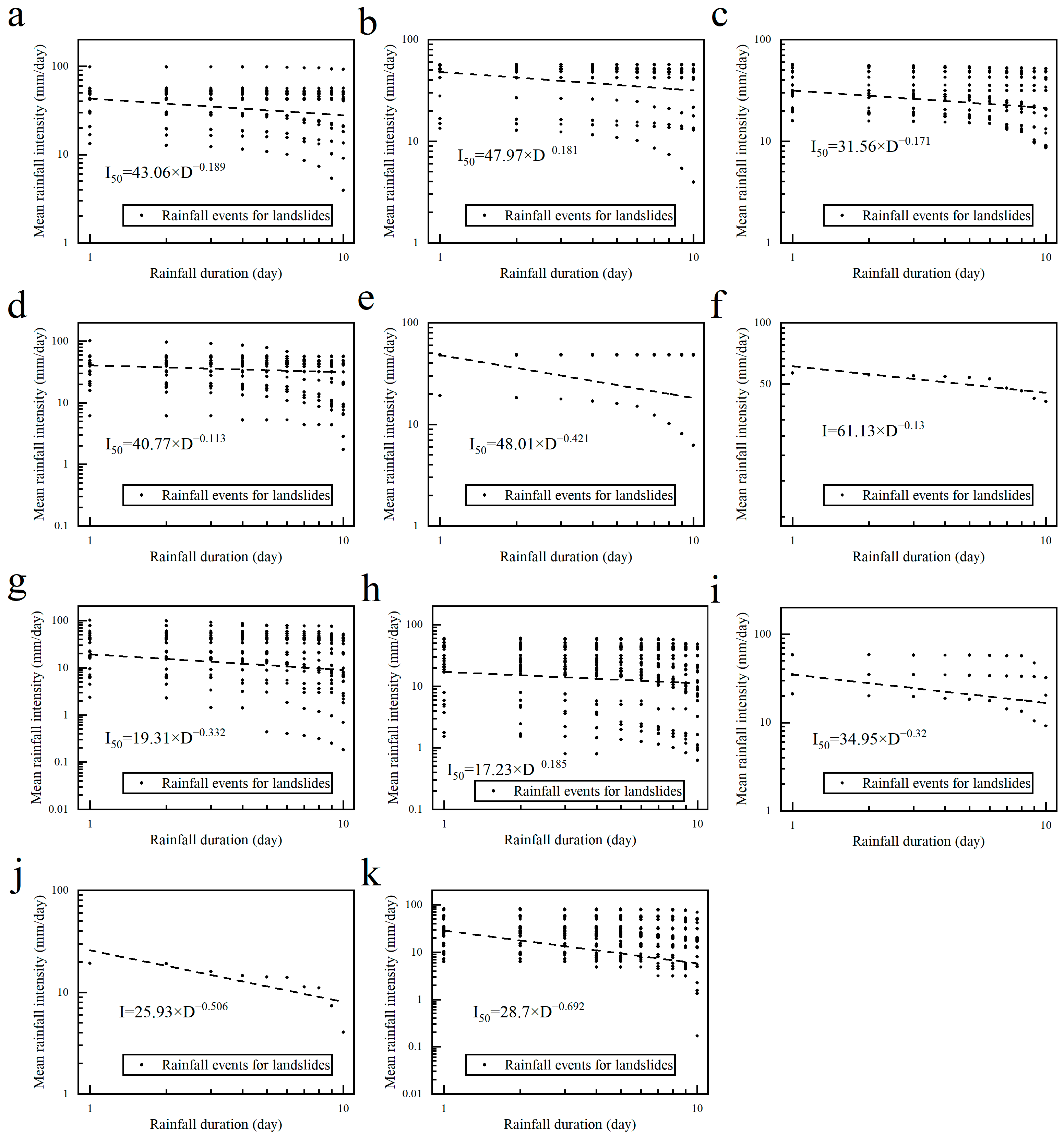
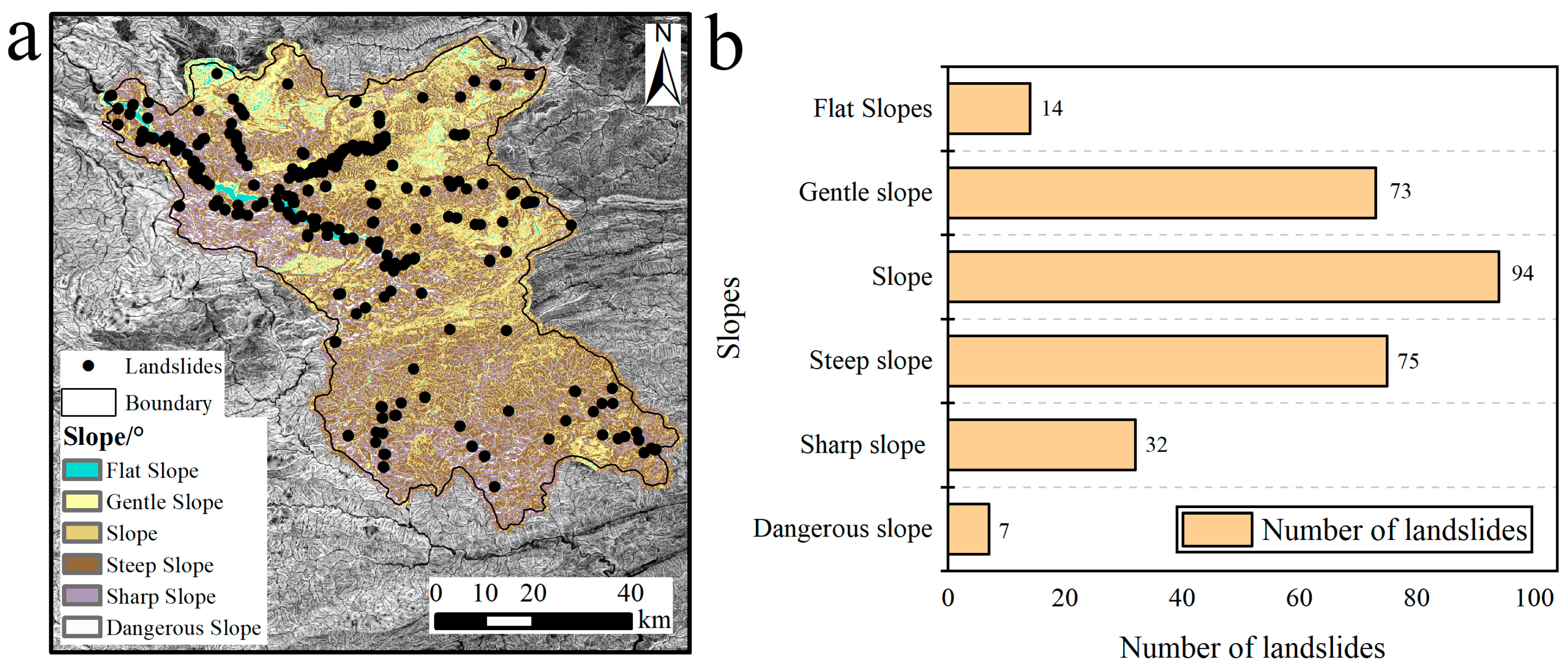



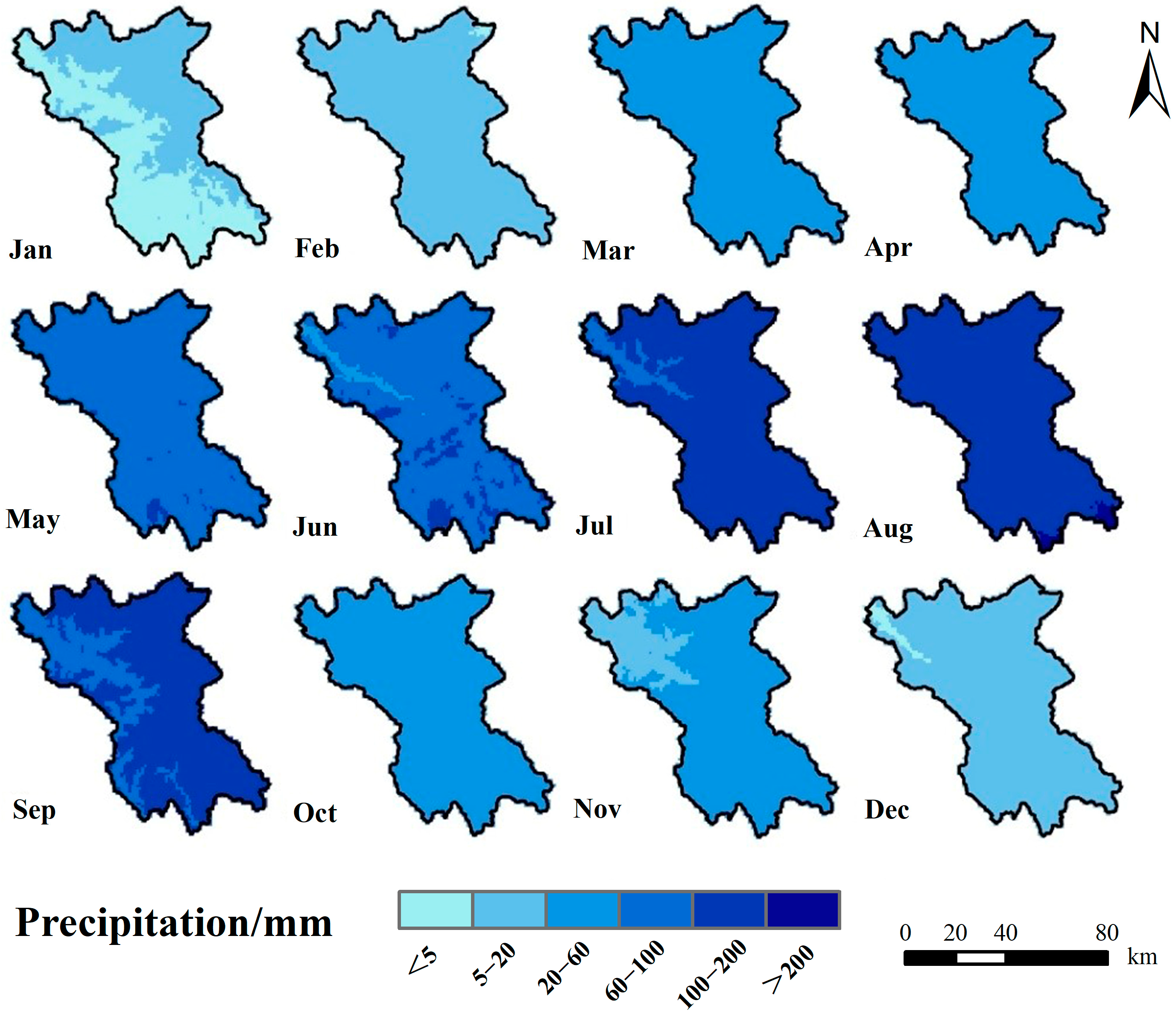
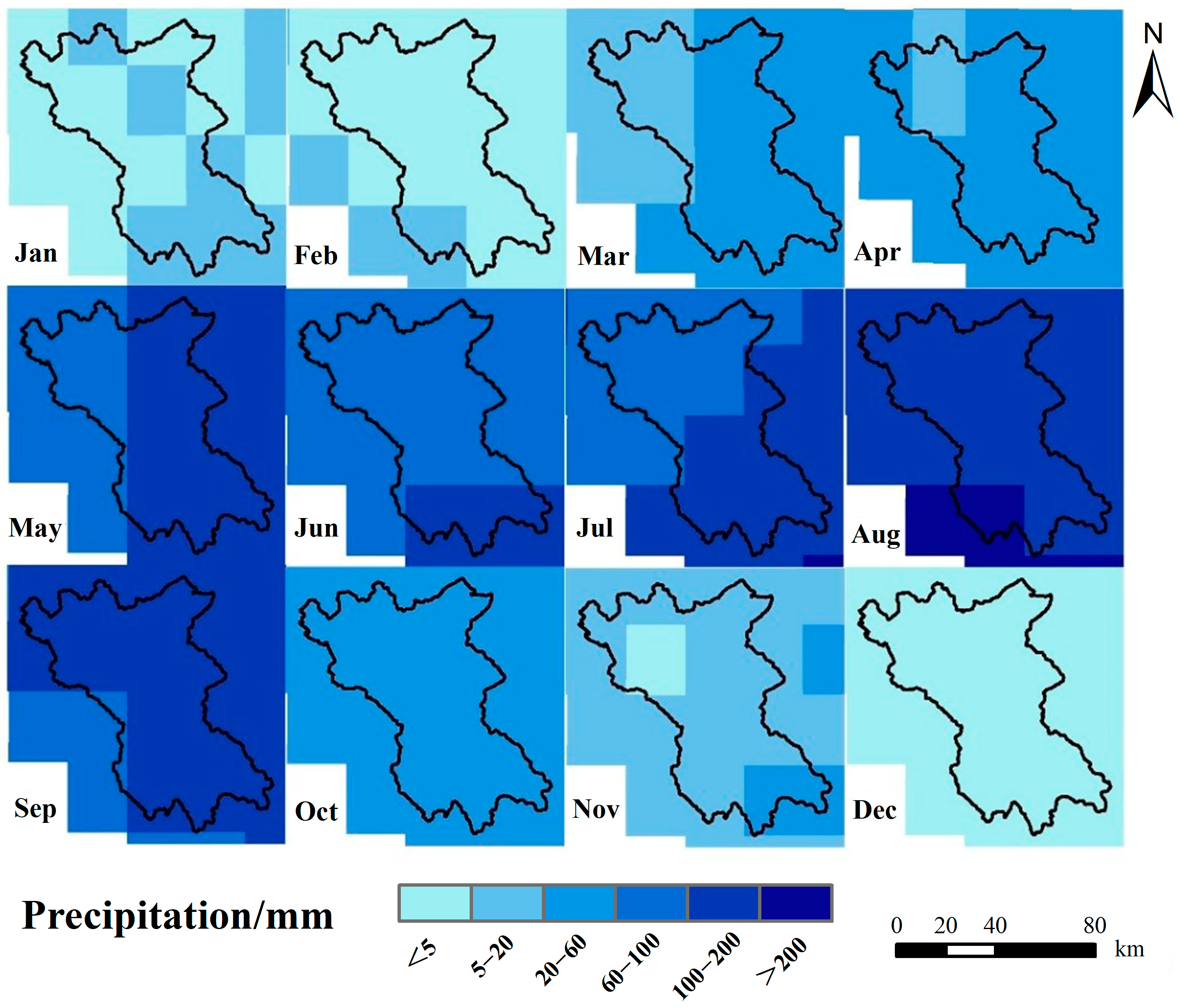
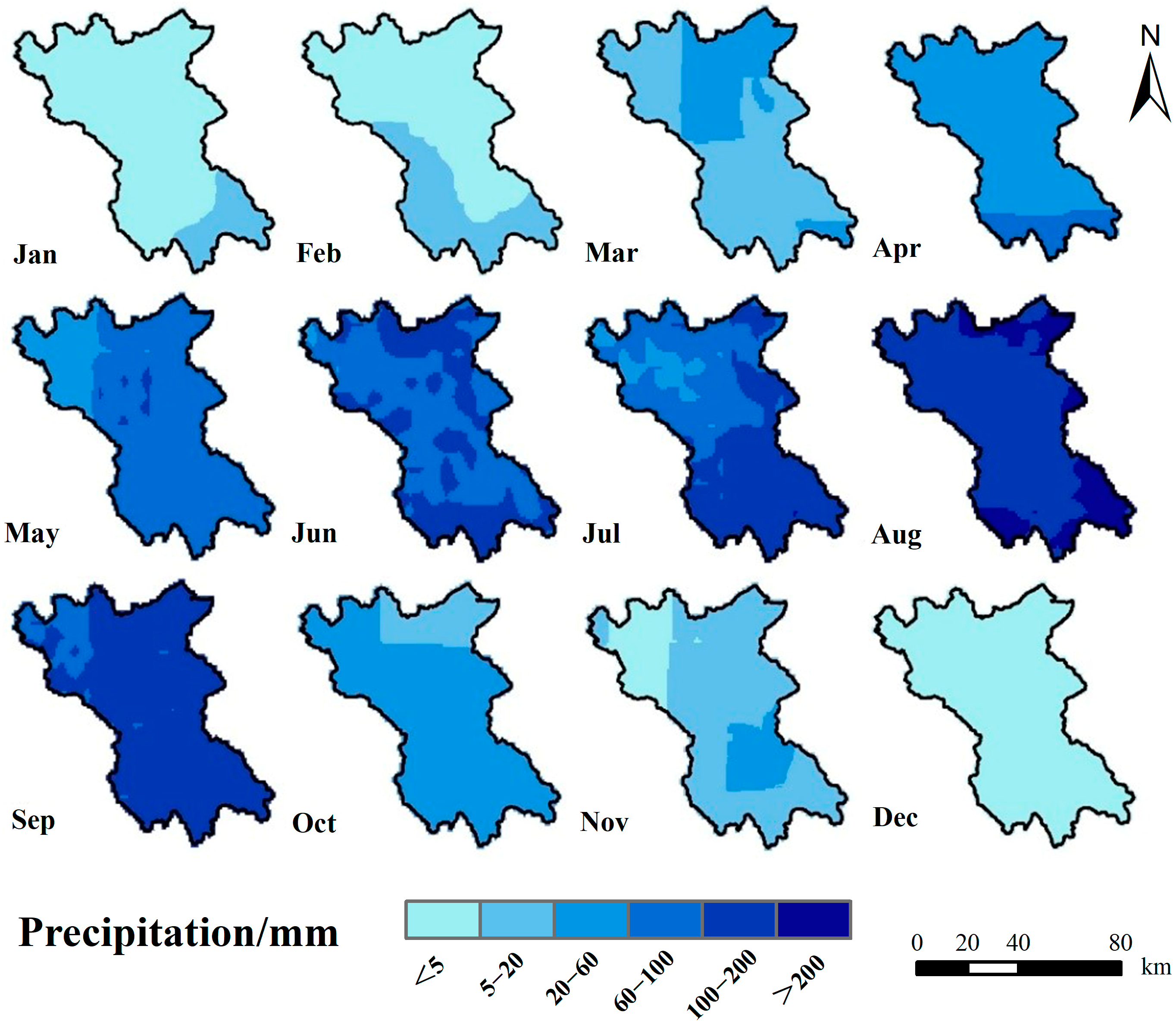
| Data | Spatial Resolution | Time Resolution | Source |
|---|---|---|---|
| TRMM 3B42 | 0.25° × 0.25° | 1 day | National Aeronautics and Space Administration (https://www.nasa.gov/, format: 28 April 2021) |
| MOD13A3 NDVI | 250 m × 250 m | 0.5 day | |
| SRTM DEM | 90 m × 90 m | — | Geospatial data cloud (http://www.gscloud. cn/, format: 5 May 2021) |
| Landslide data | — | 1 day | Bai et al. [24] |
| Landform data | 1 km × 1 km | — | Resource and Environment Science and Data Center (https://www.resdc.cn/, format: 28 July 2022) |
| Soil texture data | 1 km × 1 km | — | |
| Precipitation data | — | 1 day | China National Meteorological Information Center (http://data.cma.cn/, format: 5 May 2021) |
| Relative humidity data | — | 1 day |
| Interpolated Rainfall Threshold | |||||||||
| P | I = α × Dγ | TP | FN | FP | TN | TPR | FPR | d | |
| α | γ | ||||||||
| 10 | 1.62 | −0.986 | 35 | 0 | 1078 | 172 | 1 | 0.8624 | 0.8624 |
| 50 | 7.65 | −0.986 | 23 | 12 | 513 | 396 | 0.6571 | 0.5644 | 0.6603 |
| 90 | 26.8 | −0.986 | 6 | 29 | 187 | 976 | 0.1714 | 0.1608 | 0.8440 |
| Downscaling Rainfall Threshold | |||||||||
| P | I = α × Dγ | TP | FN | FP | TN | TPR | FPR | d | |
| α | γ | ||||||||
| 10 | 3.96 | −1.004 | 35 | 0 | 813 | 437 | 1 | 0.6504 | 0.6504 |
| 50 | 21.03 | −1.004 | 19 | 16 | 589 | 726 | 0.5429 | 0.3912 | 0.6017 |
| 90 | 50.73 | −1.004 | 5 | 30 | 133 | 1117 | 0.1429 | 0.1064 | 0.8637 |
Disclaimer/Publisher’s Note: The statements, opinions and data contained in all publications are solely those of the individual author(s) and contributor(s) and not of MDPI and/or the editor(s). MDPI and/or the editor(s) disclaim responsibility for any injury to people or property resulting from any ideas, methods, instructions or products referred to in the content. |
© 2023 by the authors. Licensee MDPI, Basel, Switzerland. This article is an open access article distributed under the terms and conditions of the Creative Commons Attribution (CC BY) license (https://creativecommons.org/licenses/by/4.0/).
Share and Cite
Ning, S.; Ge, Y.; Bai, S.; Ma, C.; Sun, Y. I–D Threshold Analysis of Rainfall-Triggered Landslides Based on TRMM Precipitation Data in Wudu, China. Remote Sens. 2023, 15, 3892. https://doi.org/10.3390/rs15153892
Ning S, Ge Y, Bai S, Ma C, Sun Y. I–D Threshold Analysis of Rainfall-Triggered Landslides Based on TRMM Precipitation Data in Wudu, China. Remote Sensing. 2023; 15(15):3892. https://doi.org/10.3390/rs15153892
Chicago/Turabian StyleNing, Shan, Yonggang Ge, Shibiao Bai, Chicheng Ma, and Yiran Sun. 2023. "I–D Threshold Analysis of Rainfall-Triggered Landslides Based on TRMM Precipitation Data in Wudu, China" Remote Sensing 15, no. 15: 3892. https://doi.org/10.3390/rs15153892





